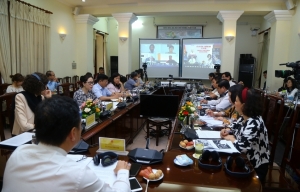Meeting skilled workforce demand in manufacturing and processing industry
 |
| Experts discussed the demand for skilled workforce in the manufacturing and processing industry |
In the first six months of this year, foreign investors poured capital into 18 industries in Vietnam, led by the manufacturing and processing industry with a total investment of $6.98 billion, according to the General Statistics Office of Vietnam.
“Vietnam has steadily turned into a manufacturing hotspot in Asia, due to its relatively large, young, and cost-competitive workforce, attractive tax regime, stable political environment, geographical advantages, and open trade policies,” Simon Matthews, regional manager of ManpowerGroup Vietnam, Thailand and Middle East shared with the webinar on July 22 with the Institute of Labour and Social Affairs under the Ministry of Labour, Invalids and Social affairs (MoLISA).
He highlighted that the strong foreign direct investment (FDI) flows helped create more business and job opportunities for Vietnamese amongst the global pandemic.
 |
| Simon Matthews, regional manager of ManpowerGroup Vietnam, Thailand, and Middle East |
A fundamental change in human resource structure
Facing the increasing wave of foreign investment in Vietnam, it is forecasted that the market will pivot away from low and unskilled workers to show higher demand for medium-to-high-skilled workers.
“Foreign-invested enterprises in the manufacturing and processing industry will lean more towards automation, which will strongly affect the demand for skilled workforce in the labour market within the next 2-3 years,” Bui Ton Hien, director of the Institute of Labour and Social Affairs (ILSSA) stated in his opening speech at the webinar.
According to a survey on the situation and demand for working skills at foreign-invested manufacturing and processing businesses in Vietnam in 2021-2023 jointly conducted by ManpowerGroup Vietnam and ILSSA, most businesses are now using cutting-edge technologies, with only 5 per cent at a low or very low adoption level. Moreover, 94 per cent of respondents shared that they will enhance their technology and automation plans in the next three years, suggesting a notable increase in demand for skilled labour.
Matthews also explained, “Foreign firms are planning to expand manufacturing operations in Vietnam to diversify their supply chains. This will bring about great opportunities for Vietnam to take manufacturing to the next level, creating thousands of meaningful jobs for the local workforce.”
Gap between supply and demand
Based on the research, more than one-fifth of surveyed businesses (21 per cent) responded that they find it difficult or very difficult to recruit skilled workers who meet the company’s requirements, especially when it comes to technical skills, work ethics, and other soft skills. Identifying the top skills and the skills gap will help businesses build appropriate talent acquisition and retention strategies.
The top two skills that are the most difficult to find include professional/technical skills and foreign language skills, according to the survey. Le Thi Kim, head of Staffing and Outsourcing Services, North of ManpowerGroup Vietnam shared, “The rapid speed of digital transformation has created several new roles not only in the world but also in Vietnam. This requires employers to reskill and upskill their workers to quickly adapt to the changes. Moreover, analytical skills, creativity/initiative taking, leadership skills, and problem solving skills are now essential.”
 |
| Le Thi Kim, head of Staffing and Outsourcing Services, North of ManpowerGroup Vietnam |
A focus group interview with 200 companies in the field showed that recruitment difficulties stem from both objective (candidate capabilities, competition, etc.) and subjective reasons (working environment and conditions, welfare and benefits, etc.).
Notably, 70 per cent of surveyed foreign-invested enterprises agreed said their greatest difficulty was to find candidates with the requisite technical/professional skills, reaffirming the gap between demand and supply of skilled workforce.
Sustainable workforce solutions
The above-mentioned research also reported that more than two-thirds (67 per cent) of foreign-invested businesses focus on re-training and enhanced training for their workers. In the future, most of them plan to re-train their workforce (86 per cent) to enhanc working capacity and business performance in the medium and long term.
Nearly half (48 per cent) of the businesses chose to recruit via staffing and outsourcing services to access talent beyond the organisation.
When asked to suggest solutions to shorten the skills gap, most surveyed companies focused on policies to support training, recruitment, and employment activities.
“We need to build a comprehensive workforce solution, engaging all stakeholders – employers, candidates, training institution, staffing services companies, and the government,” Kim summed up.
Due to the speed of digital transformation and technological revolution globally, Matthews added, “65 per cent of all jobs that Gen Z will do do not exist yet and nearly 50 per cent of all roles in manufacturing will need to change within the next 3-5 years as the industry becomes fully digital.”
“In that context, employers will need to develop an effective and holistic workforce strategy. As the world of work is changing fast and it becomes more and more challenging to find workers with suitable skills, organisations must build, bridge, and borrow the skill sets they need. That would be critical for their success in the short, medium, and long term, especially in the digital age,” he emphasised.
 ManpowerGroup and MoLISA seek sustainable employment and business model in new normal ManpowerGroup and MoLISA seek sustainable employment and business model in new normal |
 Preparing for a new generation of modern factories Preparing for a new generation of modern factories |
 Why skillset matters in Industry 4.0 Why skillset matters in Industry 4.0 |
What the stars mean:
★ Poor ★ ★ Promising ★★★ Good ★★★★ Very good ★★★★★ Exceptional
Themes: Human Capital 4.0
Related Contents
Latest News
More News
- Green jobs needed as businesses embrace sustainability (April 06, 2023 | 11:24)
- HR leaders urged to handle work management in global uncertainty (October 20, 2022 | 17:07)
- Facing the biggest HR challenges in 2022 (October 10, 2022 | 12:14)
- Solving talent shortages amid fierce human capital landscape (August 26, 2022 | 16:18)
- Employers expect hiring to increase in H2 (August 13, 2022 | 21:30)
- Stakeholders seek sustainable strategies to retain workers (June 21, 2022 | 17:54)
- Accelerating trends and renewed urgency for labour (May 05, 2022 | 14:25)
- Latest HR trends in logistics revealed (April 28, 2022 | 14:38)
- Sustainable employment under digital transformation and the pandemic (October 29, 2021 | 15:04)
- Employment security and the future of skills for Vietnamese workers in digital transformation (October 26, 2021 | 17:20)

 Tag:
Tag:

























 Mobile Version
Mobile Version